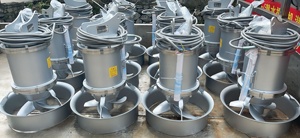Introduction to Submersible Anoxic Mixers
The submersible anoxic mixer is a sophisticated piece of equipment designed specifically for wastewater treatment processes. These mixers play a crucial role in enhancing the efficiency of biological treatment methods by ensuring proper mixing and aeration in anoxic zones. Their ability to operate underwater eliminates the need for complex surface equipment, making them an ideal choice for modern treatment plants.
Types of Submersible Anoxic Mixers
There are several types of submersible anoxic mixers available, each designed to cater to specific applications:
- Single Speed Mixers: These mixers operate at a fixed speed and are suitable for general mixing tasks in anoxic environments.
- Variable Speed Mixers: Offering adjustable speeds, these mixers can be fine-tuned based on the specific requirements of the treatment process.
- Twin Shaft Mixers: Featuring two mixing drives, these provide more efficient mixing and are ideal for larger tanks.
- High Efficiency Mixers: Designed to maximize energy use, these mixers are perfect for facilities prioritizing sustainability and cost-effectiveness.
Applications of Submersible Anoxic Mixers
Submersible anoxic mixers find a wide array of applications in various industries, particularly in wastewater treatment. Their main functions include:
- Wastewater Treatment Plants: Used for enhancing anoxic conditions needed for nitrate reduction.
- Sludge Mixing: Ideal for maintaining uniformity in sludge prior to further treatment processes.
- Biological Nutrient Removal: Critical in processes where reduction of nitrogen compounds is essential.
- Aquaculture: Employed to ensure optimal mixing and aeration conditions in fish farming and aquatic systems.
Advantages of Submersible Anoxic Mixers
Choosing a submersible anoxic mixer comes with a host of advantages, particularly for operations that demand efficiency and reliability:
- Energy Efficiency: Designed to operate with minimal energy consumption, these mixers help lower operational costs.
- Compact Design: Their submersible nature allows for space savings and simplifies installation compared to conventional mixers.
- Reduced Mechanical Wear: Being submersible minimizes the exposure of mechanical parts to corrosive atmospheres, enhancing durability.
- Versatility: Applicable across various industries from municipal to industrial wastewater treatment, ensuring broad usability.


























